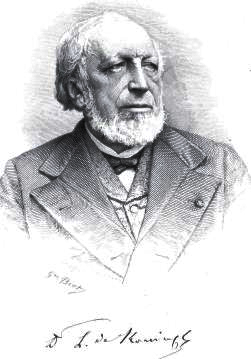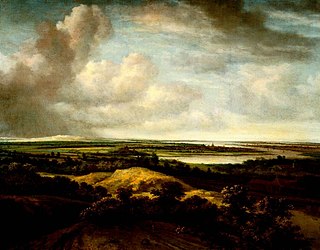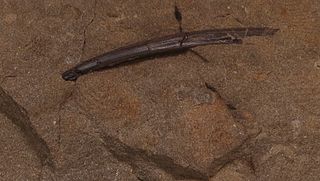Related Research Articles

Laurent-Guillaume de Koninck was a Belgian palaeontologist and chemist, born at Leuven.

Philip de Koninck, or Philips Koninck (5 November 1619 – 4 October 1688 was a Dutch landscape painter and younger brother of Jacob Koninck.

Palaeoniscum is an extinct genus of ray-finned fish from the Permian period (Guadalupian-Lopingian) of England, Germany, Turkey, North America and Greenland, and possibly other regions. The genus was named Palaeoniscum in 1818 by Henri Marie Ducrotay de Blainville, but was later misspelled as Palaeoniscus by Blainville and other authors. Palaeoniscum belongs to the family Palaeoniscidae.

Salomon (de) Koninck was a Dutch painter of genre scenes and portraits, and an engraver.
De Koninck is a surname. Notable people with the surname include:

Chonetes is an extinct genus of brachiopods. It ranged from the Late Ordovician to the Middle Jurassic.
Servaes de Koninck, or Servaes de Konink, Servaas de Koninck or Servaas de Konink, or Servaes de Coninck was a Flemish baroque composer of motets, Dutch songs, chamber and incidental music, French airs and Italian cantatas. After training and starting his career in Flanders he moved to Amsterdam in the Dutch Republic, where he was active in circles connected to the Amsterdam Theatre.
The Anomphalidae is an extinct family of fossil sea snails, marine gastropod mollusks. These are archaeogastropods which are included in the suborder Trochina. The Anomphalidae lived during the Paleozoic, from the Silurian to the Middle Permian. According to some authorities these snails belong instead to the Euomphalacea.

Charles De Koninck was a Belgian-Canadian Thomist philosopher and theologian. As director of the Department of Philosophy at the Université Laval in Quebec, he influenced Catholic philosophy in French Canada and also influenced Catholic philosophers in English Canada and the United States. The author of many books and articles in French and English, he contributed to a variety of philosophical fields including natural philosophy, philosophy of science, philosophy of mathematics, and political philosophy, but he also wrote on theology, especially Mariology.
Rineceras is an extinct genus from the nautilid family Trigonoceratidae which is part of the Trigonocerataceae, that lived during the Mississippian Period in the late Paleozoic.

Worthenia is a genus of fossil sea snails, an extinct marine gastropod genus found in the fossil record. This genus is primarily found in rocks formed during the Devonian to Triassic periods from the central areas of North America. Worthenia was named for the paleontologist Amos Henry Worthen who lived 1813 - 1888.
Cunninghamites elegans is an extinct conifer species in the family Cupressaceae and the genus Cunninghamites.
C. elegans most commonly refers to the model round worm Caenorhabditis elegans. It may also refer to any of the species below. They are listed, first in taxonomic order and, second, alphabetically.

Forbesiocrinus is an extinct genus of crinoids.

Catenipora is an extinct genus of tabulate corals in the family Halysitidae, known from the Ordovician to the Silurian.

Cosmacanthus is an extinct genus of placoderms in the extinct family Groenlandaspididae that lived during the Late Devonian in Ireland, the UK, Russia and North America. It was named by Louis Agassiz in 1845.

Bauruemys is an extinct genus of turtles in the family Podocnemididae.

Peradectes is an extinct genus of small metatherian mammals known from the latest Cretaceous to Eocene of North and South America and Europe. The first discovered fossil of P. elegans, was one of 15 Peradectes specimens described in 1921 from the Mason pocket fossil beds in Colorado. The monophyly of the genus has been questioned.
Edmondiidae is a family of bivalves belonging to the order Adapedonta.
Rhipidomella is an extinct genus of brachiopod belonging to the order Orthida and family Rhipidomellidae. Specimens have been found in Carboniferous to Permian beds in southwest Asia, the Moscow Basin, and North America.
References
- ↑ Recherches sur les animaux fossiles. LG De Koninck, 1847, volume I, page 220